Are you sick and tired of losing money on Facebook Ads?
Many advertisers just like you take a swing at a new ad campaign every day, hoping to finally hit the ball out of the park and win the game. They test a myriad of demographics and interests, use a lot of different images, and even tweak their copy over, and over, and over again.
But for some weird, unfair reason, they can’t create a profitable ad. It seems like they are just throwing money out to Facebook’s hands.
It kind of sucks, right?
Now, what if I told you that, with a few tweaks here and there, you could create your first successful ad today?
Because you can.
In this blog post, I will give you three tips that will dramatically change the way you approach Facebook Advertising forever, especially if you’re just starting.
Are you game? Great! Let’s dive right in:
Tip #1: Your Offer Will Make or Break Your Campaign
Let me start by citing the words of the late Gary Halbert—one of the best advertisers of the 20th century.
“Strong copy will not overcome a weak offer but…in many cases, a strong offer will succeed in spite of weak copy written by marketing morons.”
Gary was talking about direct response copywriting, but this principle applies to any advertising. If you have a good offer in place, you have more chances to create an ad that pays off. That’s a fact.
Just think about it.
Which offer is more attractive?

Both are great offers. I agree on that. But only one of them appeals to the right emotion.
Can you guess what offer I’m talking about?
You’re right. The second one.
Even though a 50% OFF deal is great, it doesn’t compare to the implied mechanism used by the second offer. The simple fact of feeding seven dogs will entice you to buy the shirt, especially if you are dog lover. You won’t even think you’re buying a shirt. That’s just a plus. In your mind, you’ll be helping seven poor dogs to survive.
And that’s what great offers do.
They sell without selling.
Now, I’m not saying you should start a charity to start selling on Facebook. No. What I’m saying is that you need to find a way to sweeten your offer—and do it in a way people don’t feel you’re selling them something. As Brian Clark says, “great copy doesn’t seem like an ad, it seems like a favor”.
Remember, people don’t like being sold, but they love to buy stuff.
So your mission is to make them feel that buying whatever you’re selling is their idea, not yours. That’s the basic concept I want you to understand.
Think outside the box and go beyond the typical “free shipping on orders over $50” kind of offers.
SaaS companies and information marketing businesses know this (at least the good ones.) They never sell you something. Instead, they offer free trials or give away information and create systems to build trust and entice you to buy the product without even doing any direct selling.
Of course, you can’t take the same approach in e-commerce. But, as an aspiring successful advertiser, your task is to find that compelling offer.
That said, here are a couple tips to do it:
- Read “Influence: The Psychology of Persuasion” by Robert B. Cialdini, Ph.D. — in this book, Cialdini will guide you through the six weapons of influence (reciprocation, commitment, social proof, liking, authority, and scarcity) and will show you how advertisers use them to persuade you into doing some things you wouldn’t normally do. This information will help you create more persuasive ads and identify the strategy behind the ad campaigns of your competition.
- Read as many books on psychology as you can — marketing is simply human psychology in action. The more you know about it, the most effective your offers will be. And though there’s plenty of psychology books in the marketplace, these three will definitely help you start off on the right foot: Made to Stick, The Social Animal, and — of course — How to Win Friends & Influence People.
- Look at what your competitors are doing and outsmart them — more often than not, you can create an irresistible offer by just analyzing what your competitors are doing, and then offering a “sexier” deal. Burger King, Wendy’s, and McDonald’s are famous for doing this. They continually spy on their competitors’ social media to find their most popular offers, and then create something better.
The 4 for $4 Meal: a trayful of mouth-filling glory. pic.twitter.com/JjDOFZVXuP
— Wendy's (@Wendys) January 20, 2016
5 for $4, because 5 is better than 4. pic.twitter.com/BZe8JFbKjm
— Burger King (@BurgerKing) January 21, 2016
Tip #2: Track Sales, Not Vanity Metrics
Listen:
Clicks and social engagement are important, but what really matters is how much money you make, not how many people share your ad.
Here’s what I mean:
If you’re getting a lot of clicks, it’s easy to get false expectations because your ad is apparently “working.” This is a big mistake – clicks do not necessarily mean it’s a high-performing ad (unless your only goal is to get clicks).
I can’t remember how much money I’ve lost because of this.
I used to think: “I just need to be patient, and I will see the sales coming in. After all, people are engaging, aren’t they?”
Or “I will increase the daily budget. I just need more exposure.”
But those sales never materialized, and I ended up losing money.
Now, you may think this is something silly or that there’s no way it can happen to you, but I say, don’t be so sure.
The truth is, it doesn’t matter if you’re getting thousands of shares and clicks. If you are not getting sales, something is not working. It may be your ad. It may be your landing page. It may be your audience. But whatever the case is, you need to stop the campaign and figure out what’s going on. Otherwise, you’ll keep losing money.
Now, don’t get me wrong. I’m not saying that clicks and engagement aren’t important. To some degree, they are. What I’m trying to say is that you should always keep track of your sales, scale what works, and get rid of what doesn’t work.
This way, you’ll always have a point of reference for your next ad or campaign.
In words of Jon Loomer, Founder of The Power Hitters Club, a private community for advanced Facebook marketers:
If you don’t use Conversion Tracking, you’re going to have a hard time determining which ad is actually leading to revenue. As a result, it’s very easy to make the wrong decisions when managing your ads.
This is extremely important information. Even if you’re making sales, if you don’t track which ad is leading to revenue, you’ll lose money.
Now, take a look at this screenshot:
What you’re looking at is a screenshot of an ad I ran a long time ago.
I was selling a product for $199 and, as you can see, it cost me $128.99 to get a purchase. Apparently, I was profiting $70 per sale.
The problem is that when calculating my results, I didn’t take into account some expenses—like contribution to overhead and the product cost—so instead of making $70 per sale, I was losing around $21 per purchase.
I was so excited with my “successful” ad that I didn’t notice the leak until I was already $20,000+ down.
I know, I know. It was a DUMB mistake. And it’s not directly related to Facebook Advertising.
But it’s a very common one.
That’s why you need to track everything, especially revenue.
The bottom line is this:
Sales first. Clicks and engagement, second.
If you take this approach, I guarantee you’ll learn faster and save a ton of advertising money.
Tip #3: You Don’t “Create” Successful Ads, You Build Them
Many people believe that successful campaigns are “created,” but they are not.
I mean, you can’t produce a winner ad out of thin air. No. You need to find the right information about your audience, so that you can build a campaign based on those findings.
And here’s a keyword: “Build.”
If you were to build a building, how would you go about it?
First of all, you’d start with a solid foundation, right? Then, you’d start putting together a series of building blocks to give shape to your building.
Finally, once the entire building is done, you’d start taking care of the less-important details — like painting and decoration.
My point here is, if you skipped the first steps, your building would fall really quickly. And you know what? When it comes to Facebook marketing, you need to take the same approach. You need to build your campaigns exactly as you’d build a building. Step by step, you’re collecting and putting together key data points that, eventually, will give shape to your winner ad.
These key data points are the foundation of your campaign. But, how can you find these data points? The answer is very simple, of course. You find them through testing and optimization.
Now, optimization is a simple (yet often over-complicated) concept. According to Neil Patel, optimization boils down to two things:
- Do more of what works.
- Quit doing what doesn’t work.
That’s all there is to it.
And it’s the key to building a successful campaign.
Now, here are some tips that will help you start off on the right foot:
1. Split your ad into different categories
You need to categorize the elements of an ad to simplify the testing process. Breaking down your ads into elements will help you visualize the different things you can test and optimize.
Here are the different elements you can test:
Ad Design
- Image
- Text
- Headline
- Call to action
- Value proposition
Targeting
- Country
- Gender
- Interests
- Age
- Custom Audiences
- Relationship Status
- Purchase Behaviors
- Education Level
Miscellaneous
- Landing Page/Product Page
- Ad Placement
- Campaign Objective
- Ad Type
If you’d like to learn more about targeting and categorization, Content Harmony produced an excellent guide to Facebook Ad Targeting options that is worth reading.
2. Optimize every element of your ad creative
Naturally, your ad creative will have a direct impact on your conversions. Here is where your main idea (value proposition) is expressed, and you need to take the time to optimize every element that supports that idea.
It’s surprising how many advertisers neglect this step and design an ad that simply doesn’t harmonize with the market.
Below you’ll find a simple cheat sheet that breaks down the different elements of a Facebook ad, and gives you some tips on how to optimize them for higher conversions.
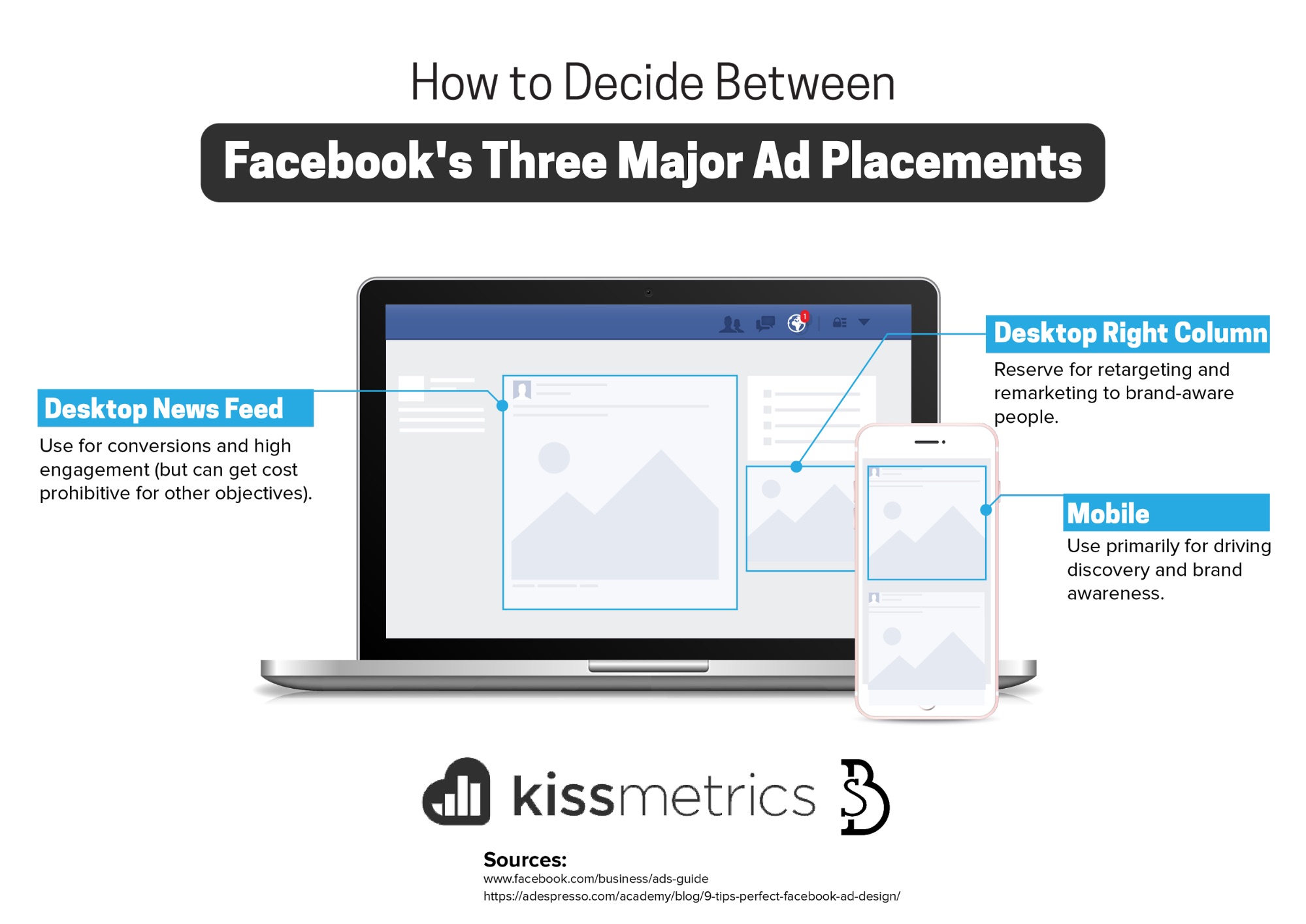
Now, if you want to dig deeper into ad creative optimization, marketing writer Brad Smith has put together a comprehensive guide that will show you everything you need to know about the topic. Make sure to read it.
3. Avoid the “spaghetti-against-the-wall” approach
If you throw a bunch of spaghetti against a wall, some of it will stick.
When it comes to Facebook Ads Optimization, you can’t take the same approach.
Of course, testing is crucial for your success, but it doesn’t mean that you should create a ton of different ads just to see which of them work.
Instead, you need a strategy.
But, how can you find this strategy?
Well, you can start by reading this guide from Social Media Examiner. You’ll learn 15 optimization strategies you can apply to your business right now. Also, BigCommerce produced an excellent roundup of Facebook Ads tips focused on ecommerce and conversions. These two posts will help you find the right angle for your business and industry.
4. Assume nothing, test everything
Take a look at the image below:
Let’s say you’re about to run the ads above.
How could you know which ad will perform best?
Some of you would say that comparing the emotional angles of each ad is the best method.
Others would say that you need to analyze the correlation between the offer and the imagery.
And another small group of smart folks would say that you only need to “Google it” (just kidding…bad joke.)
Anyways, these are insightful answers, don’t you think?
But none of them are right.
The truth is that you couldn’t possibly know which ad will give you better results until you test them.
When Adespresso ran those ads, they thought the first ad would outperform the second one. But the results were surprising:
The moral of the story?
When it comes to testing, your opinion doesn’t matter.
So remember, assume nothing. Test everything.
Tip #4: LTV Is More Important Than You Think
I love this quote from Peter Thiel, Facebook’s first outside investor:
“Long-term planning is often undervalued by our indefinite short-term world.”
How does this apply to Facebook marketing?
The answer is simple: In a bid to make a quick buck, many advertisers are missing on the tremendous opportunity that long-term planning can bring to their businesses.
Let me explain:
Assume you’re selling a $50 product, and it costs you $80 to acquire a new customer. At first glance, this doesn’t seem correct. If you’re spending $80 for every new customer, and you’re only making $50, it’s clear that you’re losing money, right?
Well, it depends…
Let’s also assume that you discovered that your LTV (Customer Lifetime Value) is $700. In this case, $80 per acquisition is not only acceptable, but utterly fantastic. You can afford to lose $30 per customer on the “front-end” of the relationship because you know that you’ll make far more money in the long run.
One of the primary reasons people fail at Facebook advertising is they don’t consider LTV when planning their strategy. They just focus on the quick sale. And the truth is until you calculate LTV and build your campaigns around it, you won’t take full advantage of your Facebook advertising.
Now, in case you’re wondering how to calculate LTV, this infographic will guide you step by step through the entire process.
Tip #5: Set Clear Goals (But Do It This Way)
This last one will sound kind of repetitive or dull. I was even tempted to exclude it from this guide. However, setting goals is crucial, and with so many people overlooking this step, I decided to talk a bit about it.
From an advertising standpoint, setting goals is vital because it helps you measure results and discover whether or not your ads and campaigns are following the right direction. Without a clear path to follow, you’ll never get tangible results.
Sure, chances are you already know all that. But how do you set the right goals?
Well, you need to start at the end…
Let’s say you want to increase your sales this year. How would you go about it? If I guess right, you’d set a goal like “40,000 units sold within 12 months” or “30,000 product sales by 2018.”
Now, setting “end” goals like these is advisable. They help you visualize the big picture and follow a clear path. The problem starts when you only set this type of goals. I mean, “40,000” can be a really discouraging number when you’ve never made that amount of sales before.
Worse yet, with “big picture
source https://blog.kissmetrics.com/unbeatable-facebook-ad-campaign/
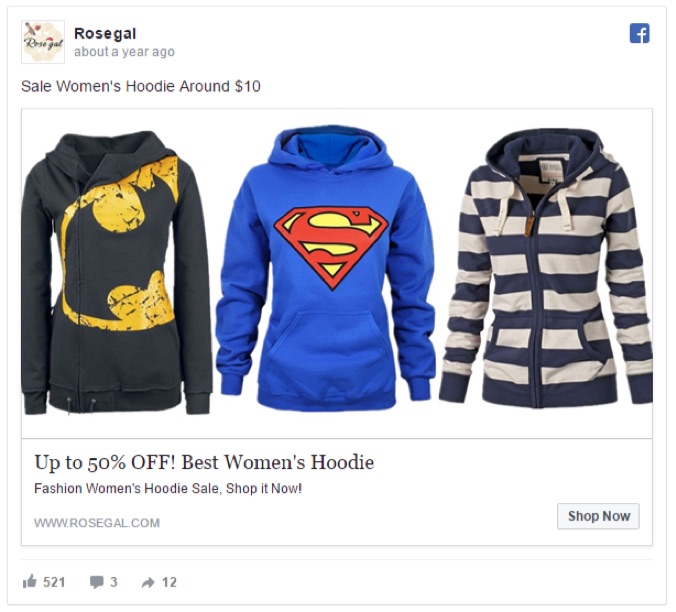
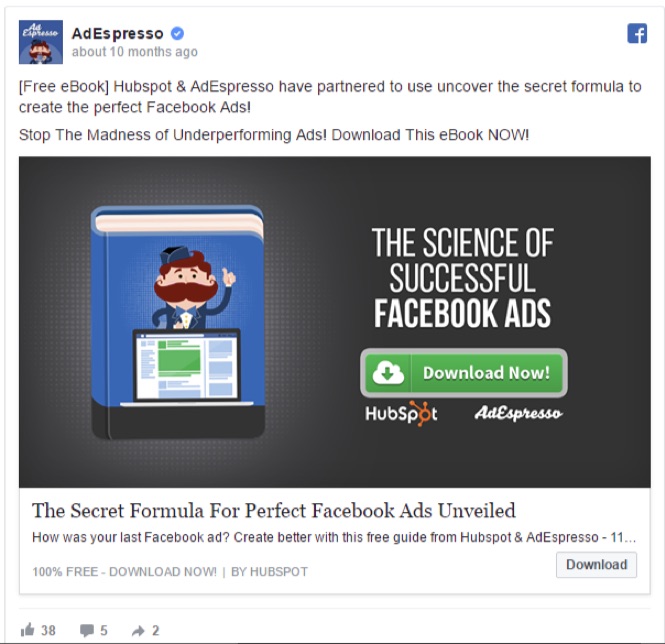

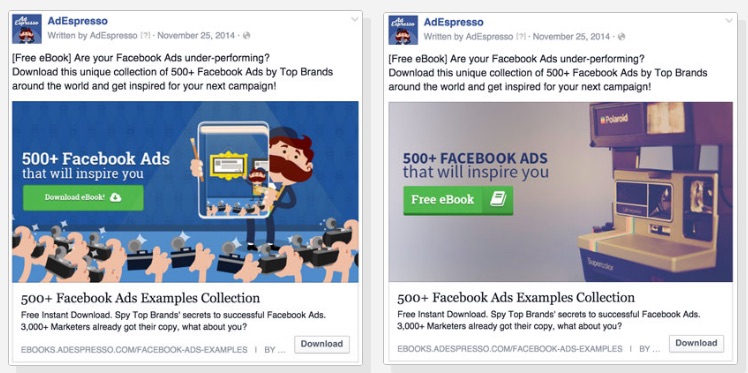
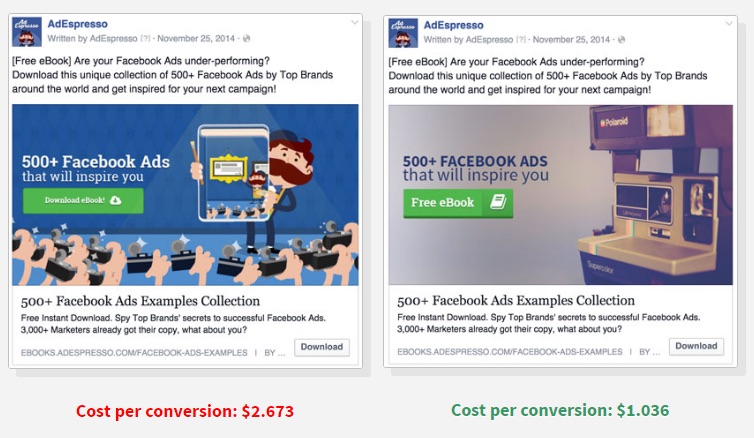
No comments:
Post a Comment